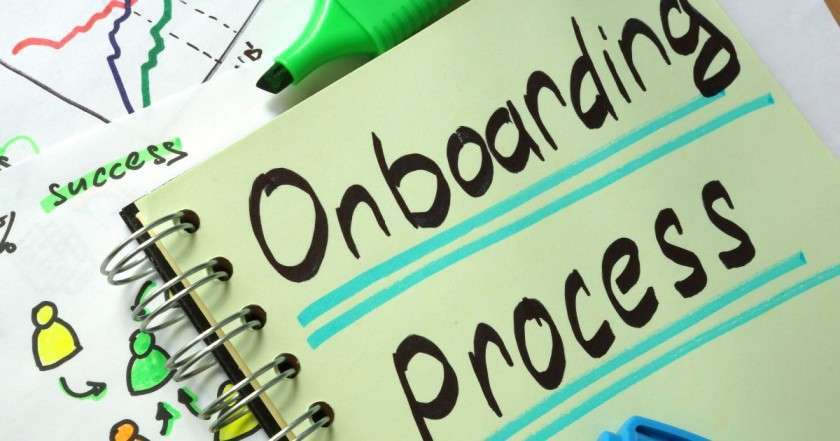Streamline Your Onboarding Process: A Revamp Guide
Are you finding it hard to keep new hires engaged and invested? This guide is for you! We will show you how to reshape your onboarding process.
Thank you for reading this post, don't forget to subscribe!Onboarding doesn’t have to be a headache. By using the right strategies, you can leave a great first impression. This guide will talk about creating personal plans and fun training. These ideas are key to making new employees want to stay, work more, and help your company grow.
Key Takeaways
- Onboarding is more than just orientation – it’s a comprehensive process that helps new hires integrate into the company.
- Efficient onboarding can lead to better employee retention, higher engagement, and heightened productivity.
- Automated onboarding can simplify the process for HR professionals and provide a more personalized experience for new hires.
- Developing a comprehensive onboarding plan with clear roles and responsibilities is crucial for success.
- Ongoing training, mentorship programs, and continuous feedback are key to keeping new hires engaged and invested in the company.
Understanding the Importance of Onboarding
Onboarding plays a key role in employee retention initiatives and organizational culture. It helps new hires get used to their roles swiftly. This fluid start to a new job is crucial as it helps find their place in the company fast.
What is Employee Onboarding?
Employee onboarding goes beyond orientation. It’s all about helping new team members get comfortable with their roles and the company’s vibe. Setting up this period well keeps new hires engaged and more productive.
Key Differences Between Onboarding and Orientation
Orientation is a short, first look at the company. It’s like a hello. But onboarding is a longer process, like a guide, lasting 3 to 6 months. During this time, new hires get to know the company deeply. They learn its culture, ways of working, and their specific jobs well.
Benefits of an Efficient Onboarding Process
Good onboarding can make a company way more productive, boosting it by over 70%. It builds a strong connection that keeps employees around longer, up by 82%. Also, new hires learn their jobs quicker, becoming fully proficient 34% faster.
An efficient onboarding plan also makes employees happier and clearer about company culture. This improves the team’s cooperation and everyone’s experience at work.
Automated vs. Manual Onboarding
Manual onboarding might feel more personal, but adding automated features improves it a lot. Doing everything by hand can make HR teams waste time on small tasks. This stops them from solving big issues. It also makes the process of bringing in new employees hard to track.
Automated onboarding, on the other hand, lets HRs give more attention to making the start better for new hires. It takes care of the paperwork and makes it all simple and organized. This way, everything can be tracked much easily.
Challenges with Manual Onboarding
Handling onboarding manually is slow and can lead to many mistakes. It keeps HR from focusing on bigger goals. Also, it makes it hard to know if the process is really working for the new employees.
Without good tracking and being reliant on paper, seeing what needs to change is tough. This makes improving and updating the process hard.
Advantages of Automated Onboarding
Automated onboarding speeds up the process and makes it less confusing for new starters. By doing things like collecting paperwork and sending welcome emails automatically, HRs have more time. They can work on making the whole onboarding experience better.
This also helps collect data that the company can use to keep making the start even better. So, the process keeps improving.
Developing a Comprehensive Onboarding Plan
To make sure the onboarding process revamp goes smoothly, a well-structured onboarding plan is key. This plan will list all activities, the process, and the time it takes. It will also clearly show what HR, managers, and new employees need to do.
Creating a comprehensive onboarding plan helps make the process smoother for everyone. It improves how new hires connect with the company (called new hire engagement strategies), and makes them more likely to stay (which is employee retention initiatives). The plan should also fit with the company’s organizational culture and how it handles change management.
Coming up with a detailed process optimization strategy is essential. It helps refresh the onboarding process revamp. You need to pick out key tasks, say who’s doing what, and set clear deadlines and goals.
| Onboarding Metric | Impact of Comprehensive Onboarding Plan |
|---|---|
| Employee Turnover Rates | Decreased turnover by ensuring new hires integrate seamlessly into their roles |
| Productivity Metrics | Increased productivity levels by implementing a well-planned onboarding strategy |
| Employee Morale and Engagement Metrics | Improved employee morale and engagement levels by addressing ineffective onboarding experiences |
| Training Completion Rates | Increased new hire training completion rates by ensuring comprehensive skill development |
| Feedback Metrics | Provided valuable insights for continuous improvement by collecting and analyzing new hire feedback |
| Performance Metrics | Indicated the positive impact of a comprehensive onboarding process on individual and team performance |
| Retention Rates | Helped assess the success of the new onboarding plan by monitoring employee retention rates |
| Engagement Metrics | Highlighted the effectiveness of the onboarding initiatives on creating a positive company culture and engaged workforce |
Using personalized onboarding plans and learning from data makes the onboarding process better. This supports new hire engagement strategies and helps with employee retention initiatives.
Starting the Process Before Day One
When starting a new job, the onboarding process begins before day one. It involves sending a welcome email and granting access to company tools. Also, there are the first meetings and training scheduled ahead of time. This makes the new hire feel valued and welcomed before they enter the office.
Setting Expectations
Before the new hire starts, it’s key to lay out their role and the onboarding timeline. This helps the new employee know what to expect right from the start. They understand their duties and align with the company’s mission. It’s about starting off right for a successful journey together.
Providing a Comprehensive Orientation Program
The first days at a new job are super important. That’s why the orientation is a big deal. It introduces new folks to the company’s ways and what it stands for. This helps them feel part of the team and gets them ready for their new journey.
Introducing Company Culture and Values
During orientation, new employees learn about the company’s goals and values. They get to see how the company builds a welcoming and positive environment. This is where they start to see how they can make a difference.
Explaining Policies and Procedures
The program also talks about the company rules and how things work. This means stuff like what benefits they get, how to use time off, and staying safe. Knowing all this from the beginning makes new hires confident and ready to jump in.
Building a solid and interesting orientation program is key. It makes new team members feel welcome and part of the team right away.
Assigning a Mentor or Buddy
Getting a mentor or buddy is great for new hires. They offer support and advice for the new job and the company’s ways. This special welcome for new hires can make them feel more connected. It also makes the join-in process better.
Benefits of Having a Mentor
Having a mentor has big pluses. Studies show new employees are 49% less likely to leave with a mentor, and 87% of companies using this technique find it works well. Mentors share what they know and help new hires get used to changes easily.
Selecting the Right Mentor
Picking a good mentor is key for the program’s success. The perfect mentor is smart, experienced, and into helping. They must be good at creating a nice learning space. Also, they should give good advice and help the new hire get settled in.
Offering Ongoing Training and Development
Learning and growing is key for success and satisfaction at work. The onboarding process must help new employees gain the skills and knowledge they need. It’s vital to give all staff chances to learn more. This helps them keep growing inside the company.
Identifying Training Needs
It’s vital to figure out what skills new employees need. This happens through tests, watching experienced workers do their job, and getting manager and HR feedback. Knowing what newcomers lack helps design training and development that works just for them.
Continuous Learning Opportunities
But learning shouldn’t stop after the first few weeks. Companies should keep offering chances to grow. This could be online classes, workshops, having a mentor, or working on special teams. Helping employees keep learning can make them want to stay. It also makes the company keep getting better.
| Onboarding Strategy | Potential Impact |
|---|---|
| Comprehensive training and development programs | Up to 50% decrease in time-to-proficiency for new employees |
| Continuous learning opportunities | Up to 20% increase in employee retention rates |
| Alignment with company culture and values | 15% improvement in employee engagement and 20% boost in employee commitment |
Onboarding process revamp
Streamlining the onboarding process means keeping what’s important, not cutting corners. It’s about finding what drags and fixing it with smart ideas. You can make things like paperwork easier, letting HR teams work more on making new hires feel welcome. Boosting how new hires feel during their start can make them more likely to stay and be productive.
Streamlining Administrative Tasks
Skipping the hassle of paperwork and dull tracking gives HR teams more space to shine. They get to make the onboarding process sweet, personal, and memorable for the newcomers. They use cool tools and tech to cut down on manual work and keep things flowing.
Enhancing the Employee Experience
Making the start memorable and good for new hires can really make a difference. It keeps people wanting to stay, do well, and feel like they belong. Making the journey fit their role, adding online stuff, and setting up ways to mingle virtually all help. This way, new coworkers feel ready, cared for, and keen to help the team succeed.
Evaluating and Adjusting the Onboarding Process
It’s crucial to always look at and change the onboarding process. This makes sure it works well and meets what new hires need. By asking new employees what they think and looking at important onboarding facts, orgs can find ways to do better. They can then make smart choices to improve the onboarding process and how new employees feel.
Collecting Feedback from New Hires
Getting thoughts from new hires is very important. Orgs can use many ways to do this, like surveys, talks one-on-one, and in groups. This deep look can show what the good and not so good parts of the plans and strategies are for new hires. It all helps to see what needs work.
Analyzing Onboarding Metrics
Beyond just getting feedback, checking important onboarding facts is key. Looking at things like how long new hires stay, how they feel, and how quickly they start producing work can show if onboarding goals are met. By looking at these numbers, orgs can find places that need more work. This helps make things even smoother for new and current employees.
Always keeping an eye on feedback and facts and making changes is crucial for getting better all the time. This way, the change to a new job is easy and good for everyone.
Best Practices for Successful Onboarding
To make onboarding successful, companies need a detailed plan that caters to each new employee. This plan should be personalized, supportive, and engaging. By doing this, organizations help new team members start off right, leading to their long-term success.
Personalized Onboarding Plans
One approach doesn’t fit all when it comes to onboarding. Effective plans are tailor-made for each new person, focusing on what they need and how they learn best. This might involve specific training, a mentor, and regular catch-ups to make sure everything is progressing well.
Fostering a Supportive Environment
Making newcomers feel valued and part of the team is key to keeping them for the long haul. To create a welcoming culture, companies can organize team activities, arrange check-ins with supervisors and mentors, and encourage friendships among colleagues. This builds a spirit of cooperation and support, making the integration smoother.
Promoting Engagement and Collaboration
Onboarding doesn’t stop once the training is over. The best programs keep up the involvement from day one. They offer chances to grow, regular chats about how things are going, and opportunities to work on various projects. This approach keeps employees committed, boosts their productivity, and makes them feel part of a united team.
Leveraging Technology for Onboarding Automation
Technology is making it simpler than ever to update the onboarding process through automated methods. This approach not only saves time for HR teams but also makes the start of work more exciting for new hires. Software and apps for onboarding make handling paperwork and tracking progress easier. And, with onboarding solutions that work on smartphones, new hires can finish these tasks whenever and wherever they are.
Onboarding Software and Applications
In the era of digital transformation, onboarding tools are key to making the process smoother. They take care of jobs like managing documents, collecting data from new hires, and tracking progress. This lets HR teams spend more time making the employee welcome. By employing process tweaks and ongoing improvements, organizations can offer a great onboarding that hooks new hires in right from the start.
Mobile-friendly Onboarding Solutions
In today’s quick-moving and more remote work world, solutions that work on mobile phones are a must. These tools mean new hires can use their own devices to do onboarding jobs when it suits them. This approach not only benefits the new hire but also feeds into the HR goal of making onboarding smooth and reachable, no matter the place or tool.
Conclusion
The modern workplace is always changing. Making the onboarding process smoother is crucial for companies. They aim to make new employees feel welcome, stay longer, and be more productive. A good onboarding plan includes personal touches, interactive training, mentors, and feedback.
Technology has also changed how companies bring in new staff. The use of automated processes and mobile apps cuts down on paperwork. This lets companies focus more on what makes employees’ starts enjoyable. It’s important for businesses to keep making their onboarding better. They do this by listening to feedback and looking at how well things are going.
Now, finding the right people for a job is tough. Companies that put effort into a smart onboarding process have an advantage. They’re better at keeping and developing their workers. This leads to a stronger, more successful company. Always trying to do better helps businesses make the most of their team. They can grow in a world where being the best is key.
FAQ
What is employee onboarding?
Onboarding is about helping new hires fit in quickly and well. It ensures they understand and become part of the company smoothly.
How does onboarding differ from orientation?
Orientation mainly covers introducing the organization once. Onboarding, however, is a longer, more detailed process. It integrates new employees into their roles and the company over time.
What are the benefits of an efficient onboarding process?
It leads to better staff retention and engagement, plus more productivity. A strong onboarding process can boost productivity by 70%.
What are the advantages of automated onboarding compared to manual onboarding?
Automation frees HR to focus on making the employee experience better. It simplifies tasks and tracks progress more effectively. This saves time and offers a more positive welcome to new hires.
What should be included in a comprehensive onboarding plan?
It should detail all activities and timelines involved. Also, it must clearly state everyone’s roles, including HR, managers, and new hires.
How can organizations start the onboarding process before the new hire’s first day?
They can send welcome emails, provide early access to resources, and set up training dates. Clear role and timeline expectations help the new hire get started smoothly.
What should be included in a comprehensive orientation program?
This program should cover the organization’s basics, like its goals, values, and culture. Policies, procedures, and benefits must also be explained. It should be interactive and allow for questions and networking.
What are the benefits of assigning a mentor or buddy to new hires?
Mentors offer support and advice for new employees. They help them adjust and understand their roles better. A good mentor is knowledgeable and keen to assist the new employee succeed.
How can organizations ensure continuous learning and development for new hires?
They need to offer skill-boosting chances during onboarding. It’s vital to continue such training for all employees. This keeps them growing within the company.
How can organizations evaluate and adjust the onboarding process?
By checking with new hires and reviewing their satisfaction, companies can gauge success. Looking at metrics like retention and productivity can show what needs improving.
What are some best practices for successful onboarding?
Creating individual onboarding plans, ensuring new hires feel valued and welcomed, and encouraging ongoing development and teamwork are key. Regular support and learning opportunities help too.
 hroptimum
hroptimum






